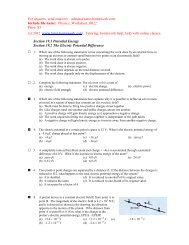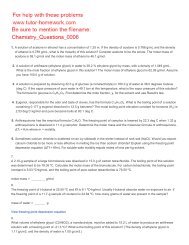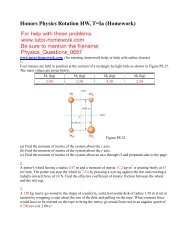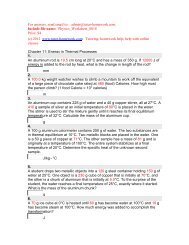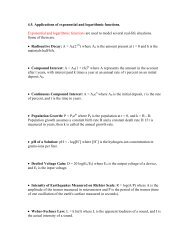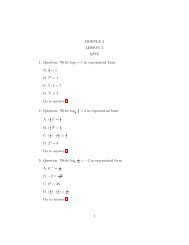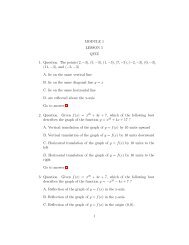midterm review (Homework) - Tutor-Homework.com
midterm review (Homework) - Tutor-Homework.com
midterm review (Homework) - Tutor-Homework.com
You also want an ePaper? Increase the reach of your titles
YUMPU automatically turns print PDFs into web optimized ePapers that Google loves.
<strong>midterm</strong> <strong>review</strong> (<strong>Homework</strong>)<br />
www.tutor-homework.<strong>com</strong> (for tutoring, homework help, or help with online classes)<br />
1.<br />
What does the metric prefix milli mean?<br />
2.<br />
How many kilometers are in 6,250,000.0 centimeters?<br />
3.<br />
Express 5,981,025,000 in exponential form using standard scientific or "e" notation (for example,<br />
105 = 1.05e2). Enter the correct number of significant figures.<br />
4.<br />
Convert 709.5 meters to centimeters.<br />
5.<br />
The concept of ____ indicates the ability of a person to measure consistently.<br />
6.<br />
The concept of ____ indicates how close the experimental answer is to the true value.<br />
7.<br />
Select the correct number of significant figures for .00698.<br />
8.<br />
How many significant zeros are in .0650030?<br />
9.<br />
Calculate the value of the following in exponential form, using standard scientific or "e" notation<br />
(for example, 105 = 1.05e2). Enter the correct number of significant figures.<br />
235.15 cm + 9.2 cm + 35.111 cm<br />
10.<br />
Calculate the value of the following in exponential form, using standard scientific or "e" notation<br />
(for example, 105 = 1.05e2). Enter the correct number of significant figures.<br />
(2.50e2 cm)(3.555e-4 cm)<br />
11.<br />
Convert 40.5°C to K. Enter the correct number of significant figures.
12.<br />
Select the correct number of significant figures for 0.00007 g of radium.<br />
13.<br />
Classify the following as homogenous mixtures, heterogenous mixtures, elements or <strong>com</strong>pounds.<br />
(a) magnesium oxide<br />
(b) salad dressing<br />
(c) water<br />
(d) iron<br />
(e) salt water<br />
14.<br />
Which elements are characterized by the filling of d orbitals?<br />
15.<br />
What is a horizontal row of elements in the periodic table called?<br />
16.<br />
To which family do sodium and potassium belong?<br />
17.<br />
To which family do argon and helium belong?<br />
18.<br />
Which element has similar properties to chlorine?<br />
19.<br />
What is the formula for potassium carbonate?<br />
20.<br />
What is the formula for calcium hydroxide?<br />
21.<br />
What is the formula for magnesium phosphate?<br />
22.<br />
What is the formula for copper (I) sulfate?<br />
23.<br />
What is the formula for aluminum phosphate?<br />
24.<br />
What is the formula for lithium oxide?
25.<br />
What is the formula for carbon tetrachloride?<br />
26.<br />
What is the formula for iron (III) oxide?<br />
27.<br />
Potassium chlorate is a rich source of oxygen. It de<strong>com</strong>poses upon heating to produce potassium<br />
chloride and oxygen. Which of the following represents the correctly balanced equation for this<br />
reaction?<br />
28.<br />
Identify the elements having the electron configurations below. Write the symbol for the element.<br />
You may use the Periodic Table.<br />
[Ne]3s 2 3p 2<br />
[Ar]4s 2 3d 8<br />
1s 2 2s 2 2p 6 3s 2 3p 6 4s 2 3d 2<br />
1s 2 2s 2 2p 6 3s 2 3p 6 4s 2 3d 10 4p 6<br />
29.<br />
What is the charge and mass in amu of a proton?<br />
30.<br />
Indicate the numbers of protons and neutrons in the following atoms.<br />
(a) 238 U<br />
(b) 33 P<br />
(c) 65 Cu<br />
(d) 15 O<br />
31.<br />
How many valence electrons are found in an atom of N?<br />
32.<br />
How many valence electrons are found in an atom of P?<br />
33.<br />
How do electrons change when atoms absorb light energy?<br />
34.<br />
Which electron configuration cannot exist?<br />
35.<br />
Different isotopes of the same element have different numbers of what?<br />
36.<br />
Which subatomic particle(s) make(s) up most of the mass of an atom?
37.<br />
Which orbital filling diagram is correct for the 2p subshell of nitrogen?<br />
38.<br />
J.J. Thomson was experimenting with the cathode ray tube and observed that the rays were attracted<br />
to a positively charged plate. He is credited with the discovery of which of the following?<br />
39.<br />
How many orbitals are contained in the 3s sublevel?<br />
40.<br />
Bromine consists of two major isotopes with the following percent abundances and atomic masses:<br />
79 Br (50.54% and 78.918 amu) and 81 Br (49.46% and 80.916 amu). Calculate the average atomic<br />
mass of bromine.<br />
41.<br />
Silver consists of two major isotopes with the following percent abundances and atomic masses:<br />
107 Ag (51.84% and 106.90509 amu) and 109 Ag (48.16% and 108.90476 amu). Calculate the average<br />
atomic mass of silver.<br />
42.<br />
25 g of a radioactive substance is left after 16 days of decay. What is the half life of the substance if<br />
the original sample had a mass of 100 g?<br />
43.<br />
How many orbitals and electrons are in each of the following sublevels?<br />
orbitals electrons<br />
s sublevel<br />
p sublevel<br />
d sublevel<br />
f sublevel<br />
44.<br />
Enter the symbol for the element represented by each of the following ground state configurations<br />
for the neutral atom.<br />
1s 2 2s 2 2p 6 3s 2 3p 2<br />
[Rn]7s 1<br />
[Ar]4s 2 3d 10 4p 5<br />
1s 2 2s 2 2p 6 3s 2 3p 6 4s 1 3d 5<br />
1s 2 2s 2 2p 6 3s 2 3p 6<br />
45.<br />
What is the correct arrangement of the electron spins in a 2p 4 sublevel? (Select all that apply.)
46.<br />
How many valence electrons are in an atom having the electron configuartion<br />
1s 2 2s 2 2p 6 3s 2 3p 6 4s 2 3d 5 ?<br />
47.<br />
When you are determining the amount of heat energy necessary to melt 10 g of ice at 0°C, which of<br />
the following values do you need to <strong>com</strong>plete the calculation?<br />
48.<br />
Copper has a specific heat of 0.387 J/g·°C. How much energy is required to raise the temperature of<br />
180. g of copper from 40.5°C to 169.0°C?



